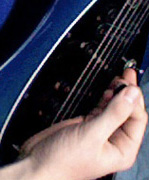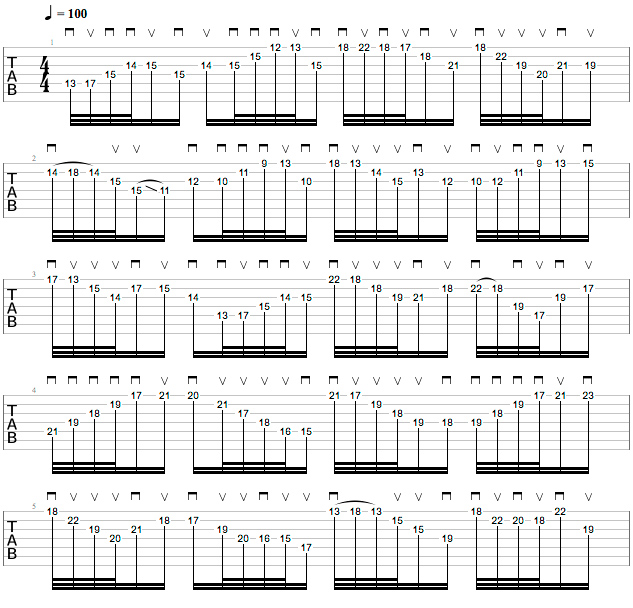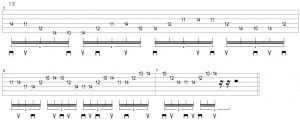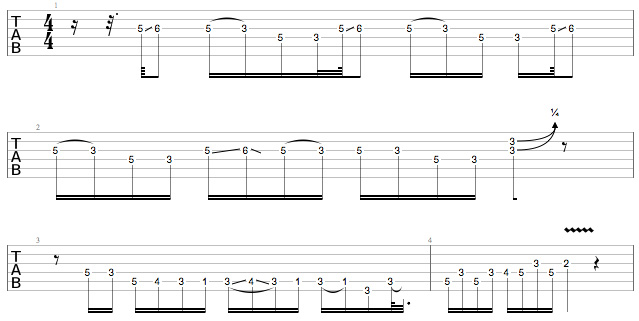What’s that? You want to learn some metal guitar? You’re a beginner, too? No way! You came to the right place, my friend. Welcome to the first lesson in this beginning metal guitar series. With these lessons, I will lay the foundations for developing solid and precise metal technique. Whether you’re a novice guitarist or just want to brush up on some technique, this series will offer beginner-intermediate exercises and concepts to help you on your way to metal mastery. With patience, practice and a decent electric guitar and amp, you’ll be chugging out brutal riffs in no time. If you need a guitar, read Part 1 and Part 2 of my Buying Your First Guitar articles. If you already have a guitar, plug in and let’s get going.
This lesson will focus on the importance of rhythm guitar in metal music and how to go about developing proper palm muting and downstroke technique – two essential skills in metal rhythm guitar.
The Importance Of Rhythm Playing/Pick Hand Development
There’s a misconception that rhythm players aren’t as good as lead players – that they exist to support the shredding solos of their flashier brethren. Wrong. Of course lead guitar is exciting, but rhythm guitar is an integral part of metal’s energy, power and complexity. Taking time to practice rhythm along with lead will help you become a well-rounded and versatile guitarist.
A good starting point for rhythm guitar is right hand (or left if you’re a lefty) development. Developing a tight and precise picking hand will enable you to play complex rhythms and breakdowns, write interesting riffs and achieve accuracy and consistency. Let’s take a look at two key techniques – palm muting and the downstroke.
Palm Muting
 Palm muting is the cornerstone of metal guitar, but its title can be deceiving. The actual palm of the right hand isn’t touching the guitar, rather it is the meaty side of the hand between the pinky finger and wrist joint that does the dampening.
Palm muting is the cornerstone of metal guitar, but its title can be deceiving. The actual palm of the right hand isn’t touching the guitar, rather it is the meaty side of the hand between the pinky finger and wrist joint that does the dampening.
Be aware that the goal of this technique is not to silence the note as the name would suggest. The overall tone of the note is heard but it is not allowed to ring out, tightening the sound of the attack as well as shortening its duration. This is the sound you want.
Try picking the low E string without anything touching it. Obviously, the note rings out. To achieve a proper palm mute, place that fleshy part of your right hand at the meeting point of the strings and the guitar’s bridge. Now pluck the string.
You will notice that the flesh of your hand prevents the note from ringing. If your right hand is shifted too far to the right of the bridge, the tone will either go sharp or not sound at all. You want to keep the E pitch pure even as you alter its timbre, so it may take some adjusting to find that sweet spot that brings out the tone properly.
Downstrokes
Downstrokes are great for creating an aggressive attack for riffs and breakdowns. While muting the low E string, hold your pick between your index finger and thumb and pluck the string in a downward motion toward the floor. Repeat.
To practice the palm muting and downstroke technique, let’s look at the following figures. These exercises may appear simple, but taking time to develop a crisp palm muting tone and accuracy with a metronome will pay off. For a great article on practicing with a metronome, see Guitar Messenger’s Using a Metronome Effectively series.
Figure 1

This figure contains straight palm-muted eighth notes using repeated downstrokes. Start at 60bpm with your metronome. There will be two notes per tick, eight notes for the four beats in the measure. Since the left hand isn’t doing anything here, look at your right hand as you do this exercise. Focus on the palm mute and listen for a consistent tone.
Repeat the straight eighth note sequence as long as you can while maintaining accuracy and a good tone. Increase the metronome’s tempo gradually. At faster speeds, a consistent downstroke brings out an attack that is distinctly different from alternate picking.
Figure 2

This is the same palm muting exercise as the first, this time using alternate picking, which is down, up, down, up etc. Make sure that the downstroke and upstroke tones are uniform, and repeat until your hand is fatigued and can’t play in time. Increase the metronome tempo gradually – consistency is key.
Over time, you will be able to efficiently alternate pick at high tempos. Take your time though, because jumping ahead too much can lead to sloppiness, which is a stylistic choice better made due to preference rather than necessity. You want to be a rhythmic machine.
Figure 3

Ah, triplets. This figure shows eighth note triplets. Alternate pick these but pay attention to the picking as you end up starting every other triplet with an upstroke. Again, listen for a uniform tone being sounded from the down and upstroke.
Figure 4

Figure 4 is the same eighth note triplet rhythm, but played with only downstrokes. Notice the differences in tone, and in the challenges it presents.
Figure 5

This exercise utilizes a repeating pattern of two sixteenth notes and one eight note. The grouping feels similar to a triplet, but unlike a triplet trio’s three equal notes, two of these notes are half the length of the third. This rhythm creates the characteristic ‘gallop’ feel that is common with bands like Iron Maiden.
Notice how the picking isn’t strictly alternating up and down. Each chunk of three notes begins with a downstroke. Eventually, you’ll find that you can accent certain notes, say for instance, DOWN, up, down, DOWN, up, down, etc. Gallops and triplets are great for breakdowns. As you get more comfortable with playing these in time, you’ll be able to write some cool rhythms.
Figure 6

Figure 7

Figure 8

Figures 6-8 are the same as figures 2, 3 and 5, except they use sixteenth notes. You might need to set your metronome to a slower speed to keep the notes consistent.
Again, these are relatively simple exercises, but by spending time each day to slowly and accurately practice them, you will develop a sense of timing that will enable you to play along to click tracks when recording and lock in with a drummer and bass player in bands. There’s nothing wrong with simplicity in your early days as a guitarist, or anytime you learn a new technique or style. Consistent and slow practice will get you results.
Essential Listening
Throughout this series, I will provide three essential listening albums per lesson that demonstrate the concepts we have discussed. Listening to great guitarists will inspire you, expand your ideas on what is possible on the guitar and help keep you on track to becoming the guitar hero you want to be. This month’s EL is rooted primarily in thrash metal, in which you will hear precise palm muting, downstrokes and interesting rhythms. Crank these albums up, but also do a bit of active listening to identify what is going on rhythmically and technically in the guitar parts.
Metallica, Master of Puppets, 1986
 For many, this is THE essential thrash metal record – a perfect introduction to true 80’s thrash metal and the reason Metallica are Metallica. This is the band at their peak of technique and creativity. Lars Ulrich, although not known as a particularly technical drummer, provides an extremely energetic rhythmic assault. The now-deceased Cliff Burton’s bass presence is warm and powerful, and Kirk Hammett’s leads are tasteful, melodic and ripping.
For many, this is THE essential thrash metal record – a perfect introduction to true 80’s thrash metal and the reason Metallica are Metallica. This is the band at their peak of technique and creativity. Lars Ulrich, although not known as a particularly technical drummer, provides an extremely energetic rhythmic assault. The now-deceased Cliff Burton’s bass presence is warm and powerful, and Kirk Hammett’s leads are tasteful, melodic and ripping.
The real star on MOP though, is The Almighty James Hetfield – the driving force that makes the album still sound as heavy today as it did over 20 years ago. Hetfield’s rhythm playing is impeccable and it demonstrates how rhythm playing is integral to the metal genre. His right hand is freakishly tight and articulate and his downstrokes are just nasty.
Take a look at the title track ‘Master of Puppets.’ The main riff uses downstrokes exclusively – a feat that is very challenging to execute up to speed. The riff itself isn’t that challenging – in fact, it’s relatively easy when alternate picked. It’s not at all easy to downpick the entire thing as Hetfield does, but it sure sounds heavy that way. Also listen to the chorus riff on ‘Orion’ – another riff that isn’t particularly challenging for the fretting hand, but the rhythmic variations in it spice up what could easily be a bland and redundant riff. This album is a must-have.

Megadeth, Rust in Peace, 1990
In the metal community, there is a long-standing Metallica vs. Megadeth argument. Fanboys will likely point out why one band is superior and why the other sucks, but they are both amazing bands and experiencing each of their strengths for yourself will definitely benefit your playing.
Dave Mustaine, former Metallica guitarist and frontman of Megadeth, is an amazing rhythm player who combines complex rhythmic and chordal variations with simple chugging and tight palm muting to create jazz-like metal riffs.
Check out ‘Holy Wars…The Punishment Due,’ ‘Tornado of Souls’ and ‘Take No Prisoners.’ This classic record also features awesome solos from Marty Friedman, and some seriously metal songs that never stray from E standard tuning – which goes to show that you don’t need deep, dropped tunings to sound heavy.
Black Label Society, 1919 Eternal, 2002
 Black Label Society is a departure from this lesson’s other two recommendations, which are clear and classic thrash metal, but that doesn’t mean you won’t hear plenty of terrific chugging riffs throughout the BLS catalogue.
Black Label Society is a departure from this lesson’s other two recommendations, which are clear and classic thrash metal, but that doesn’t mean you won’t hear plenty of terrific chugging riffs throughout the BLS catalogue.
Zakk Wylde, former Ozzy Osbourne guitarist, frontman of BLS and bearded metal icon, is famed for his shredding capabilities, but his riffs are the epitome of heavy and often times are refreshingly rooted in simplicity. Songs like ‘Bleed for Me,’ ‘Genocide Junkies’ and ‘Graveyard Disciples’ contain lots of chunky palm muting.
Unlike the Metallica and Megadeth albums, 1919 Eternal reflects the modern trend of placing rhythm guitars in drop-tunings, so you although you’ll learn plenty about metal rhythm by listening to the album, you won’t be able to play along with all of Zakk’s parts until you get comfortable taking your guitar out of standard tuning.
In my next lesson, I will take us further with more palm muting concepts and common chord diads to get you on your way to writing crushing riffs. Have fun practicing!















